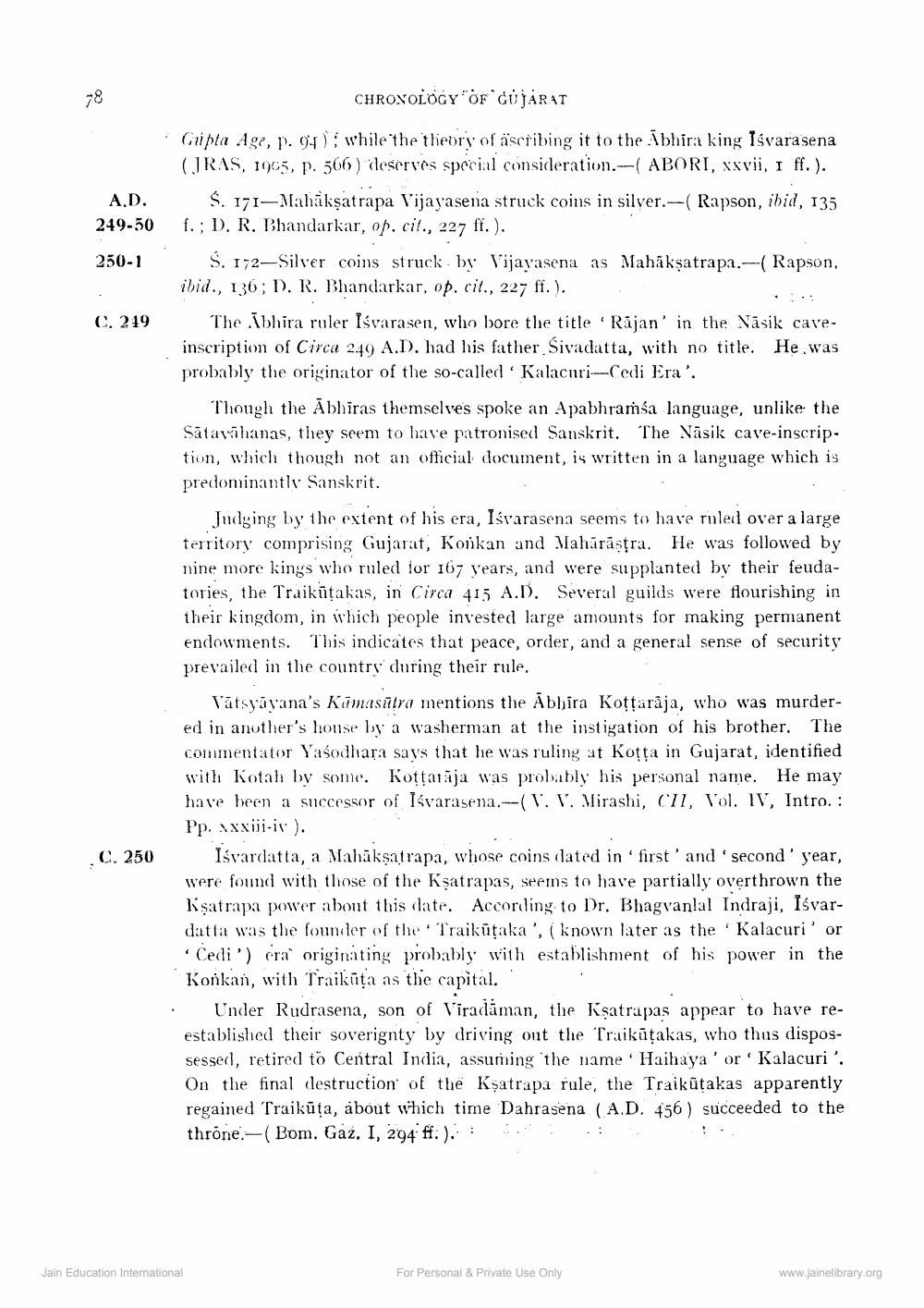________________
CHROXOLOGY OF GUJARAT
A.D. 249-50 250-1
C. 219
Gripta Age, p. 94); while the theory of ascribing it to the Abhira king Tśvarasena (JRAS, 1905, p. 566) deserves special consideration.-( ABORI, xxvii, 1 ff.).
$. 171- Mahåksatrapa Vijayasera struck coins in silver.-- Rapson, ibid, 135 f.; D. R. Bhandarkar, op. cit., 227 ff.).
$. 172—Silver coins struck by Vijayasena as Mahâksatrapa.---( Rapson, ibid., 136; D). R. Bhandarkar, op. cit., 227 ff.).
The Ibhira ruler Isvarasen, who bore the title Rājan' in the Nāsik caveinscription of Circa 249 A.D. had his father Sivadatta, with no title. He was probably the originator of the so-called . Kalacuri-Cedi Era'.
Though the Abhiras themselves spoke an Apabhramsa language, unlike the Satavahanas, they seem to have patronised Sanskrit. The Nāsik cave-inscrip. tion, which though not an official document, is written in a language which is predominantly Sanskrit.
Judging by the extent of his era, Isvarasena seems to have ruled over a large territory comprising Gujarat, Konkan and Mahārāsýra. He was followed by nine more kings who ruled for 167 years, and were supplanted by their feudatories, the Traikatakas, in Circa 415 A.D. Several guilds were flourishing in their kingdom, in which people invested large amounts for making permanent endowments. This indicates that peace, order, and a general sense of security prevailed in the country during their rule.
.C. 250
Vätsyāyana's Kimasātra mentions the Abhira Kottarāja, who was murdered in another's house by a washerman at the instigation of his brother. The commentator Yasodhara says that he was ruling at Kotta in Gujarat, identified with Kotah by some. Kottaraja was probably his personal name. He may have been a successor of Isvarasena.--(1. V. Mirashi, CII, Vol. IV, Intro. : Pp. xxi-ir).
Išvardatta, a Mahākṣatrapa, whose coins dated in 'first' and 'second year, were found with those of the Kşatrapas, seems to have partially overthrown the Ksatrapa power about this date. According to Dr. Bhagvanlal Indraji, Išvardatta was the founder of the Traikūtaka', i known later as the Kalacuri' or
Cedi') cra' originating probably with establishment of his power in the Konkan, with Traikīta as the capital. • Under Rudrasena, son of Viradāman, the Ksatrupas appear to have reestablished their soverignty by driving out the Traikūtakas, who thus dispossesserl, retired to Central India, assuming the name . Haihaya' or ' Kalacuri'. On the final destruction of the Ksatrapa rule, the Traikütakas apparently regained Traikūta, about which time Dahrasena (A.D. 456 ) succeeded to the throne.-(Bom. Gaz, I, 294 ff:. : : .
..
Jain Education Intemational
For Personal & Private Use Only
www.jainelibrary.org




